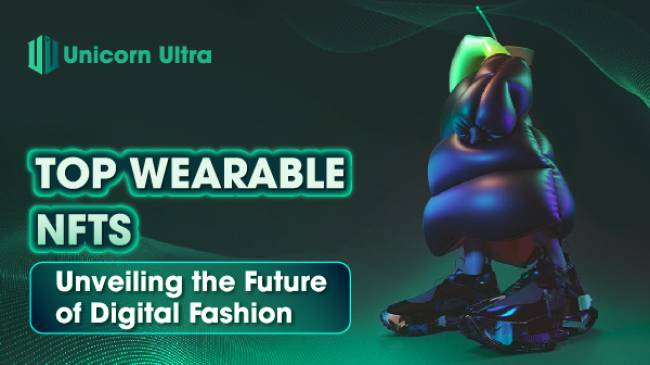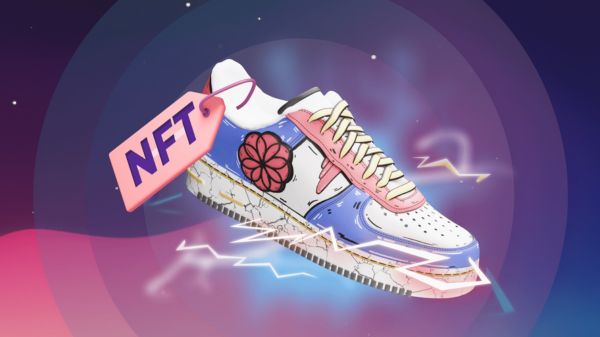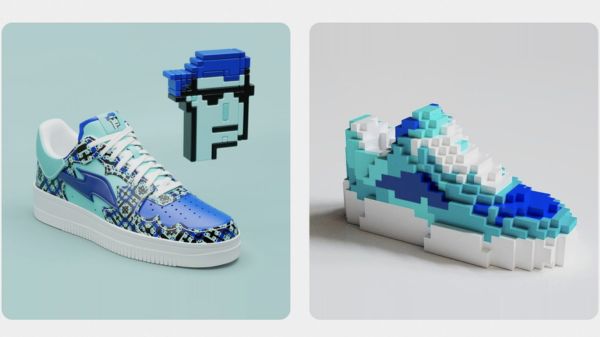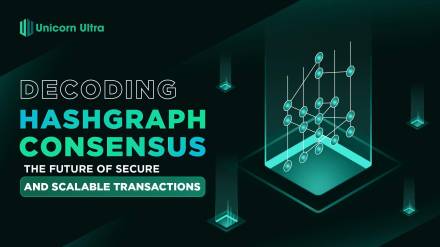Wearable NFTs? The idea of wearing something that only exists on the blockchain might sound strange at first, but the NFT wearable market and its future function in the Metaverse is expected to become the next big trend in the NFT space. In this blog we will find out what NFT wearables are, and then we’ll look at top NFT Wearables.
Table of Contents
Top NFT Wearables

Adidas
Adidas has established a strong presence in the digital fashion world, launching its first NFT collection, Into The Metaverse, in collaboration with Bored Ape Yacht Club. With digital land ownership in The Sandbox and the Adidas Virtual Gear Genesis Collection, Adidas continues to innovate in the metaverse.
Puma
Puma's Black Station platform offers a unique blend of digital exploration and shopping experience. With the launch of Black Station 2, Puma expands its metaverse presence and plans to release new footwear, starting with the Fast-RB running shoe.
Gucci
Gucci has embraced NFTs and immersive experiences, launching the SuperGucci collection and establishing its presence in the Sandbox and Otherside metaverses. The Otherside Relics collection offers exclusive silver necklaces for land NFT holders.
Nike
Nike's acquisition of RTFKT Studios has propelled its digital fashion offerings. With the launch of .SWOOSH, a marketplace platform, Nike allows users to purchase virtual products and engage in community design competitions.
Louis Vuitton
Louis Vuitton's NFT trunks and the Louis The Game mobile app showcase its foray into the digital luxury market.
Ralph Lauren
Ralph Lauren made history by accepting cryptocurrency as a form of payment in its Miami store, signaling its openness to emerging technologies.
Burberry
Burberry's collaboration with Mythical Games and its presence on Blankos Block Party and Roblox demonstrate its integration of NFTs into gaming platforms.
Dolce & Gabbana
Dolce & Gabbana's successful Collezione Genesi NFT collection and partnership with UNXD's Metaverse Fashion Week showcase their commitment to exploring the potential of NFTs in fashion.
Prada
Prada's monthly NFT drops and the introduction of phygital tank tops challenge traditional fashion conventions.
Tiffany & Co
Tiffany & Co's NFTiff collection, which sold out in minutes, demonstrates the brand's ability to create buzz and demand for luxury digital jewelry.

How to buy NFT Wearables?
To buy NFT wearables, you'll typically need to follow these steps:
1. Set Up a Crypto Wallet: Before purchasing NFT wearables, you'll need a cryptocurrency wallet that supports the blockchain where the NFTs are minted and traded. Some popular NFT marketplaces use Ethereum (ERC-721 or ERC-1155) or other blockchain networks like Binance Smart Chain (BSC) or Flow. Consider using wallets like MetaMask, Trust Wallet, or Rainbow Wallet that are compatible with various blockchains.
2. Acquire Cryptocurrency: You'll need cryptocurrency to buy NFT wearables. Depending on the blockchain, you may need Ether (ETH) for Ethereum-based NFTs or other cryptocurrencies like Binance Coin (BNB) for BSC-based NFTs. Purchase the required cryptocurrency from a reputable exchange and transfer it to your crypto wallet.
3. Connect Your Wallet to NFT Marketplaces: Connect your crypto wallet to the NFT marketplace where the wearables are listed. You can usually find a "Connect Wallet" or "Sign In" button on the marketplace's website. Follow the prompts to connect your wallet.
4. Browse NFT Wearables: Once your wallet is connected, browse the marketplace's collection of NFT wearables. Look for the wearables you are interested in and explore their details, including images, descriptions, and rarity.
5. Place a Bid or Buy Instantly: Some NFT marketplaces use auction-style bidding for NFTs, while others offer a fixed price for immediate purchase. If the wearable is listed for auction, you can place a bid, and if your bid wins, the NFT will be yours. If it's available for immediate purchase, click on the "Buy Now" button to acquire the NFT instantly.
6. Confirm the Transaction: When buying an NFT, your wallet will prompt you to confirm the transaction. Review the details of the transaction, including the gas fee (transaction fee), and approve the purchase.
7. Ownership and Display of NFT Wearables: Once the transaction is confirmed on the blockchain, you'll officially own the NFT wearable. You can check your wallet to see your newly acquired NFT. Some marketplaces also allow you to display your NFT wearables in virtual worlds or metaverses.
8. View and Trade NFT Wearables: You can view and manage your NFT wearables in your crypto wallet or the NFT marketplace where you made the purchase. Depending on the blockchain and marketplace, you may also have the option to trade, sell, or lend your NFT wearables.
It's essential to be cautious and do your research before making any NFT purchases. Verify the authenticity and legitimacy of the NFT wearables and the reputation of the marketplace. Additionally, be aware of the risks associated with gas fees, market volatility, and potential scams in the NFT space. As with any investment, only spend what you can afford to lose, and consider diversifying your NFT portfolio.
How to use NFT Wearables in games and apps?
Using NFT wearables in games and apps involves integrating these unique digital assets into the respective platforms. NFT wearables are non-fungible tokens that represent digital items, such as character skins, accessories, or virtual clothing, that can be owned and traded on blockchain networks. Here's how NFT wearables can be utilized in games and apps:
- Game Integration: Game developers can integrate NFT wearables into their games by connecting the game's smart contracts to the blockchain where the NFTs are minted. This integration allows players to buy, sell, and trade NFT wearables within the game's ecosystem.
- NFT Wallet Integration: Players will need a crypto wallet that supports the blockchain where the NFTs are minted. Game developers can facilitate this by providing in-game wallet integrations or allowing players to connect external wallets compatible with the blockchain.
- Owning NFT Wearables: Players who own NFT wearables can equip or use them within the game or app. For example, in a virtual world game, players can dress up their avatars with the NFT wearables they possess.
- Virtual Real Estate and Decorations: NFT wearables can extend beyond character customization. In some games or virtual world platforms, NFTs can represent virtual real estate or decorative elements like furniture and artwork.
- Utility and In-Game Functionality: Some NFT wearables can have utility beyond aesthetics. They may provide in-game bonuses, access to exclusive areas, or specific abilities, depending on the game's mechanics.
- Limited Edition Events: Game developers can create limited edition NFT wearables that players can earn or purchase during special events. These limited edition NFTs can have increased rarity and value, making them highly sought after.
- Cross-Platform Interoperability: NFT wearables can be designed to be interoperable across multiple games and apps. This means a wearable acquired in one game could also be used in another game or virtual environment.
- Community Rewards and Governance: Some games and apps offer NFT wearables as community rewards for active participation or governance activities. Players can earn NFTs by contributing to the development or growth of the platform.
- Secondary Market Trading: Players can trade NFT wearables on secondary marketplaces, where they can buy, sell, or exchange these assets with other players.
- Collaborations and Partnerships: Game developers can collaborate with artists, brands, or other game studios to create exclusive NFT wearables based on existing intellectual properties, fostering unique and exciting collaborations.
Overall, NFT wearables offer a new level of ownership, rarity, and customization in gaming and virtual environments. They create new opportunities for players to have unique experiences, express themselves creatively, and participate in the growing digital economy centered around blockchain-based assets. As this technology continues to evolve, NFT wearables are likely to become even more prevalent in gaming and other digital applications.

What Makes Fashion NFTs Valuable
Fashion NFTs derive their value from factors such as rarity, exclusivity, and the demand within the community. Limited editions, collaborations with renowned designers or brands, and unique artistic styles can significantly increase the value of fashion NFTs. Additionally, the reputation and influence of the creator or brand behind the NFT can contribute to its value in the market.
How to Make Money with Fashion NFTs
There are several ways to monetize fashion NFTs. These include:
Buying and Selling: Purchasing fashion NFTs at a lower price and selling them at a higher price when their value increases can yield profits.
Collecting and Trading: Building a collection of rare and valuable fashion NFTs and trading them with other collectors can be a profitable venture.
Collaboration and Partnerships: Collaborating with fashion brands or designers to create limited-edition fashion NFTs can lead to financial opportunities through sales and royalties.
Virtual Fashion Shows and Events: Participating in virtual fashion shows or organizing events where fashion NFTs are showcased can attract attention, drive sales, and create revenue opportunities.
The Future of NFT Wearables
The future of NFT wearables looks promising, as these unique digital assets continue to gain popularity and adoption in the gaming and virtual worlds. Here are some potential developments and trends that could shape the future of NFT wearables:
- Enhanced Interoperability: NFT wearables may become more interoperable, allowing players to use their assets across various games and virtual platforms seamlessly. This interoperability will increase the value and utility of NFT wearables, as players can enjoy their virtual possessions in different environments.
- Integration with Virtual Reality (VR) and Augmented Reality (AR): As VR and AR technologies advance, NFT wearables could be integrated into immersive virtual and augmented reality experiences. Players might physically wear NFT wearables through VR headsets or use them as AR overlays in real-world environments.
- Cross-Chain Compatibility: With the growth of multi-chain ecosystems, NFT wearables could become cross-chain compatible, enabling users to use their NFTs on different blockchain networks. This would promote decentralization and give users more options for storing and using their digital assets.
- Dynamic NFT Wearables: NFT wearables could evolve beyond static digital items. Developers might create dynamic NFT wearables that change appearance or behavior based on certain conditions or interactions, making them more engaging and personalized.
- Licensing and IP Protection: Brands and artists may explore NFT wearables as a means of licensing their intellectual property. This could lead to official collaborations, where popular brands offer limited edition NFT wearables to fans and collectors.
- In-Game Governance and Rewards: NFT wearables could play a role in decentralized governance systems within games and virtual worlds. Players who own certain NFT wearables might have voting power in decision-making processes or receive rewards for contributing to the community.
- Environmental Impact Considerations: As the NFT space continues to grow, there may be a focus on reducing the environmental impact of NFT minting and transactions. Solutions like energy-efficient blockchains or layer 2 scaling may be adopted to address these concerns.
- Physical/Digital Hybrid NFTs: The line between physical and digital assets could blur further, with NFT wearables representing both virtual items and real-world products. This could lead to exciting opportunities for collectibles and gamified ownership experiences.
- Integration in E-commerce and Social Media: NFT wearables might find their way into e-commerce platforms and social media networks, allowing users to showcase and trade their digital assets in more diverse online environments.
- Regulatory and Legal Considerations: As NFT wearables become more widespread, regulatory frameworks and legal considerations may evolve to ensure consumer protection, prevent fraud, and address copyright issues.
Overall, the future of NFT wearables will likely be marked by innovation, creativity, and increased adoption. These unique digital assets offer exciting opportunities for gamers, collectors, artists, and developers, creating new ways for people to engage with digital content and express themselves in virtual spaces. As the technology and use cases continue to evolve, the NFT wearables market will remain a dynamic and influential force in the blockchain and gaming industries.
Conclusion
In conclusion, as the NFT market and virtual fashion industry advance, new opportunities for monetization and financial success are likely to arise. It is crucial to stay informed, be innovative, and seize opportunities in this rapidly expanding space. By embracing the technological advancements of Top NFT Wearables, you can unlock new adventures and possibilities. So, venture into this exciting realm and discover how you can potentially profit from the future of digital fashion. Follow https://uniultra.xyz/ to update more interesting knowledge about blockchain.






